Surface drilling data improve fracture modeling and reservoir simulation, Midland basin
Modeling unconventional reservoirs requires increasingly complex physics to capture and describe the phenomena that affect the performance and efficiency of wells. This presupposes sufficient input data to constrain the models. Field development, especially in the Midland basin, more often prioritizes factory mode drilling and completions over basic data acquisition. Reservoir modeling efforts are hampered by the detrimental impact of the resulting “data desert.” It becomes a vicious cycle of poorly constrained models, providing diminishing actionable value and cutting data acquisition budgets.
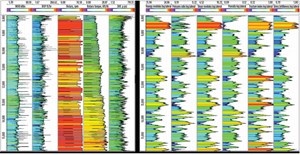
The first shale boom, followed by a collapse in oil prices, incentivized the development of many technologies, especially in the realm of reservoir modeling and simulation, but as new development continues, it becomes increasingly difficult to deploy these technologies without the proper data to drive them.
The introduction of the continuum multi-scale approach, and the use of surface drilling data, provide the unique opportunity to address both the lack of data and the increasingly complex physics. In the absence of wireline logs and seismic, surface drilling data collected at each well is used at different scales, ranging from wellbore to reservoir scale. In this process called “inverse design and validation,” the information contained in the surface drilling data is used: 1) during drilling to optimize the landing zone and geosteering; 2) during the design of the completion to geoengineer the stages while accounting for the variability of the rock; and 3) to build 3D models that allow the correct estimation of petrophysical and geomechanical properties and stresses needed in 3D planar frac simulators, in addition to fluid-flow simulation. By augmenting publicly available data with drilling data, robust reservoir models can be developed of both geological and geomechanical properties.
Surface drilling data’s application in the unconventional well cycle. When using a rigorous workflow that combines multiple disciplines, the information contained in the surface drilling data can be extracted and used in multiple stages of an unconventional well’s development. During drilling and immediately afterwards, the authors have shown in previous publications the benefits of deriving, in real time, geomechanical logs, pore pressure, stresses and natural fracture indices, and propagating them in 3D for geosteering and planning ahead of the bit. The 3D models derived from the drilling-derived logs enable the driller to remain in a tight window dictated by geomechanical properties, which will ultimately affect the performance of the stimulation and the resulting production.
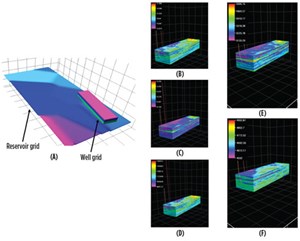
Engineers have shown how the drilling-derived logs can be used to geoengineer completions to provide the necessary 3D inputs to frac simulators. The authors, in previous publications, have illustrated the “inverse design and validation process,” where multiple wells with only surface drilling data are used as a basis for a 3D modeling effort, to better understand the stimulated reservoir volume of two zipper-fraced wells. Although this work proved effective, additional refinements are necessary to extract the full value of the technique.
MIDLAND BASIN CASE STUDY
The workflow below illustrates how surface drilling data can be transformed to enrich traditional wireline data, to provide the inputs required by fast physics-based simulation tools to address complex problems. A pad with two wells in the Midland basin is used to illustrate this workflow.
Extracting value from surface drilling data. The mechanical specific energy (MSE) computed from commonly available surface drilling data, such as torque (T), rate of penetration (ROP) and weight on bit (WOB), has been widely used to improve drilling efficiency. Most of the recent MSE applications for completion optimization use surface drilling data, which do not represent MSE at the bit. The challenge in unconventional wells is how to reduce the application of costly downhole equipment to measure downhole MSE, but still acquire accurate results.
The solution is the corrected MSE, calculated in real time using the surface drilling data, the wellbore geometry, and drilling equipment parameters to estimate the friction losses along the drillstring. This technology, being deployed across North and South America, the Middle East and China, uses advanced drilling and wellbore mechanics to estimate the multiple factors that create frictional losses in real time. Once these losses are estimated correctly, they can be used to rectify the MSE measured from surface drilling data.
Figure 1A shows the typical input available on most rigs: 1) weight on bit; 2) ROP; 3) RPM; and 4) torque processed to estimate pore pressure and stresses, as well as the critical geomechanical logs, Fig. 1B. Although concepts used to derive the geomechanical logs appear to be straightforward, the mechanics required to make accurate predictions are extremely complex. Not accounting for multiple details will result in the inability to make quantitative predictions of these key properties along the wellbore.
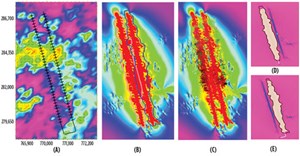
When engineers are successful at modeling these key aspects affecting drilling data, the critical geomechanical logs will emerge, accurately describing pore pressure and stresses. Given that all unconventional wells require stimulation, these common data provide the necessary information to geoengineer the completion and ultimately increase efficiency.
3D modeling using geostatistics and machine learning. The relatively large number of wells drilled in unconventional plays, combined with the estimation of critical mechanical logs at all these wells, provides an opportunity to propagate well information into a 3D reservoir model. Since many companies do not have seismic on their acreage or, for cost reasons, do not plan to license the existing seismic, these multiple logs derived at every well allow the construction of reliable 3D reservoir models built in a stratigraphic framework. In such cases, geostatistics can be used to estimate the distribution of gamma ray, porosity, Young’s Modulus, Poisson’s ratio and shear modulus.
However, the pore pressure, minimum stresses and natural fracture are more complex, continuous properties that need to be estimated with neural networks and other machine learning tools, able to capture the complex geologic reasons that control their variability.
One major reason for propagating these rock properties in 3D is to provide the information to the 3D planar frac simulator. To achieve this goal, all the wells are used together in a large reservoir grid to create the 3D models from which smaller well grids will be extracted around a well or a pad, Fig. 2A.
With this approach, all the available well data will be used to improve the 3D distribution of the key properties needed for the 3D planar frac simulator, Fig. 2B-F. The other benefit of these derived 3D models will be the estimation of the stress gradients resulting from the interaction between the regional stress and the three sources of perturbation created by the local geology: 1) variable geomechanical properties; 2) pore pressure; and 3) natural fractures, all available in 3D from the logs derived from surface drilling data.
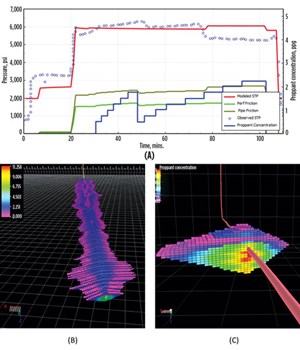
Using reservoir geomechanics to estimate stress/strain. The propagation of a hydraulic fracture depends largely on the stress gradients present near, and beyond, the wellbore. The variable geology interacts with the regional stresses and creates these local stress gradients, which are modeled and validated with microseismic data. A major geologic factor causing changes in the magnitude and orientation of the local stresses is the natural fracture system. The previous section shows how the continuous 3D natural fracture and pore pressure distribution were derived with machine learning tools, while the other rock properties were derived using geostatistical tools. Hence, all inputs needed for reservoir geomechanics are available.
The first result of the reservoir geomechanics approach is the differential stress that could be used to geoengineer completions. The advantage of using differential stress for geoengineering completions is the ability to consider the complex geology beyond the wellbore. In other words, well-centric approaches, such as those relying entirely on using a reference log derived from surface drilling data, are approximations that work only if the geology does not vary around the considered well. If the geology is variable, and there is variability of the geomechanical properties, natural fractures and pore pressure, then the best approach is to use the derived 3D models as input in the reservoir geomechanics approach.
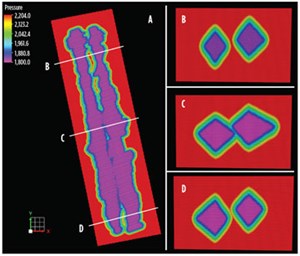
Field examples from the Wolfcamp demonstrated that the resulting differential stress, validated with a prediction of the microseismic data, captures the variable stress field around the well, Fig. 3A. Hence, when applying pressure on the hydraulic fracture faces to simulate the fracing process, the resulting strain captures the asymmetric deformation caused by hydraulic fracturing, as confirmed by the ability to predict microseismicity, Fig. 3B. Using these validated strain models (Fig. 3C), the gross geomechanical half-lengths derived from the strain envelope (Fig. 3D, E) could be estimated and used as a constraint in the 3D planar frac simulator, which will discretize the volumetric SRV captured in the strain, Fig. 3B.
Constrained 3D planar frac analysis. Given the vertical and lateral variability of the key rock properties used as input in a 3D planar frac simulator, it is imperative that the frac simulator use an actual 3D distribution of the properties needed for the simulation. Because both the 3D distribution of rock properties derived from the surface drilling data and the 3D planar frac simulator can use these data, this step is straightforward. Additionally, the geomechanical half-lengths capturing the lateral stress gradients are used as constraints, ensuring a reasonable estimate of the fracture heights. Using these constraints as inputs in the 3D planar frac simulator, the pressure during fracing is matched efficiently by altering only the pipe and perf friction, and the leakoff coefficient, which depends on the input porosity or natural fracture model, Fig. 4A. The resulting frac geometry along the wellbore (Fig. 4B), or at one stage, shows the major lateral and vertical variations, due to the variable rock properties captured by the surface drilling data and reservoir modeling efforts, Fig. 4C. With this result at each well, we have all the data required for reservoir simulation.
Evaluating well interference. The motivation and the unique features of the Fast-Marching Method (FMM) simulator used in this study were described in the literature. The 3D models and frac geometry derived in the previous sections were input in the FMM simulator, along with the fluid properties and other input data. The resulting pressure depletion at the end of the simulation, derived from the FMM simulator, shows the same features as those seen in the pressure depletion, estimated in a classical reservoir simulator. In this study, we use an FMM simulator to examine the pressure distribution in an aerial view (Fig. 5A) and a cross-section view, Fig. 5 B-D. Notice, that along the wellbore, there are some areas of stimulation overlap, while other areas received very little frac fluid/sand.
The benefit of the FMM simulation is that the results were derived in less than one minute. Using this rapid evaluation tool, engineers can leverage multiple constraints derived from surface drilling data to find the optimal balance between net present value (NPV) per well, or per section, estimated in a few days. Using the current industry methods to achieve this objective will take several weeks and will have a large uncertainty if limited log data and/or no seismic are available, as was the case in this study.
CONCLUSION
The use of surface drilling data provides valuable reservoir information along each wellbore. These data include the estimation of geomechanical logs, pore pressure, stresses, porosity and natural fractures. These rock characteristics can be used to enrich traditional wireline data in reservoir geomodelling efforts. These 3D reservoir models provide additional value for the subsequent reservoir geomechanics, 3D planar frac design and reservoir simulation effort.
When using these 3D models, and their results in a Fast Marching Method simulator, the impact of the interference between two wells can be estimated quickly while providing similar results as those derived with a classical reservoir simulator. This fast and constrained approach allows the correct estimation of NPV for each development scenario. ![]()
ACKNOWLEDGEMENTS
The authors would like to thank FracGeo’s Xioapeng Li, Srichand Poludasu, and Shruti Oza for their contributions to this case study.


